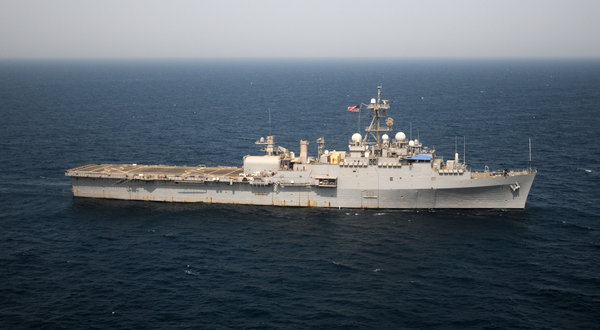
The keel for the ship, the Ponce, was cast in 1966, and the vessel, nearing the end of its service, was to have been scrapped. But the Ponce was reborn as a floating forward base for staging important military operations across the region - the latest example of the new American way of war.
The first mission of the reborn Ponce was designed to be low profile and defensive, as an operations hub for mine clearing in the Strait of Hormuz, a counter to threats from Tehran to close the vital commercial waterway. In that role, the Ponce will be a launching pad for helicopters, a home to underwater diver teams and a seaborne service station providing fuel and maintenance for minesweeping ships.
But with the relatively simple addition of a modular barracks on the deck, the Ponce can also be a mobile base for several hundred Special Operations forces to carry out missions like hostage rescue, counterterrorism, reconnaissance, sabotage and direct strikes. Even with the addition of the barracks, there is ample room for helicopters and the small, fast boats favored by commandos.
Allies and friends are important, but they can veto American missions initiated from bases on their territory. The Ponce operates from international waters. Surprise and speed are critical to military success; the Ponce can sail close to areas of conflict. And having the ability to carry out different missions for different branches of the armed services is more valuable than having a weapons platform that does just one thing for one branch of the military.
Iranian leaders see the Ponce differently, of course, and they have lashed out at the American deployments, accusing Washington of mounting a provocative military buildup. (The American reinforcements also include a doubling of minesweepers to eight and the addition of Air Force fighter and attack jets.) An Iranian Revolutionary Guards commander even threatened that his nation would counter the moves by ordering a buildup of missiles that could endanger American warships and allied bases in the region.
The Navy is convinced that the capability provided by the Ponce is essential to future military operations, and it has proposed that Congress continue a four-year, $1.2 billion program to build two new vessels dedicated solely to be what the service terms "afloat forward staging bases." Allison F. Stiller, the Navy's deputy assistant secretary for ship programs, said the two ships, now under construction, were the first vessels built specifically for the job, as opposed to warships temporarily assigned the mission.
The first of the new ships should be available by 2015, and the second a year later, if Congress approves the budget requests.
"The afloat forward staging base gives us the ability to deliver this mine countermeasure capability directly to the scene of operations," said Rear Adm. Kenneth M. Perry, vice commander of the Navy's mine and antisubmarine warfare command.
Admiral Perry is based in San Diego, but he described the Ponce's role in a telephone interview from the Navy's Fifth Fleet headquarters in Bahrain, where he has moved to oversee mine-clearing exercises and, potentially, mine-clearing missions.
For decades, the military has used various warships and service vessels as platforms for staging operations, whether the Pacific island-hopping campaign of World War II or the river campaigns of the Vietnam War. In a more recent and creative example, the Navy emptied the aircraft carrier Kitty Hawk of attack jets before the invasion of Afghanistan in 2001 and turned it over to Special Operations forces for raids against Taliban targets.
The idea of creating a dedicated fleet of floating bases gained traction in the 1990s, as the military retrenched after the collapse of communism and looked for ways to operate independently near contested areas. One idea was to tow giant offshore oil platforms to a conflict zone and lash them together to form an airport large enough for helicopters and even transport planes. It was ultimately dismissed because the platforms would have been too vulnerable to attack and insufficiently mobile.
The design of the floating bases expands on what is called the mobile landing platform, which is used to get Marines and their war-fighting equipment from ship to shore. Those landing platforms are built by General Dynamics Nassco, which is also constructing the new basing ships. To the untrained eye, the vessels look very much like an oil tanker.
To accommodate the many missions of different military branches aboard the floating base, the vessels will be outfitted with a helicopter hangar on the deck and with access portals for small, fast boats. A hospital suite and a water purification facility also are on board.
"It will be a ship that is 'purpose built' to have that capability, whereas we have taken Ponce and converted her to provide that capability, or we have taken another ship offline to do the mission," said Ms. Stiller, the Navy official.
Pentagon and Navy officials note that the decades-old quest for an afloat forward staging base was accelerated, and finally became a reality, owing to pressure from the global combatant commanders - especially from senior officers at Central Command and Special Operations Command.
"Mine countermeasures operations are critical to protecting sea lines of communication by mapping out and neutralizing sea mines," said Lt. Col. T. G. Taylor, a Central Command spokesman. "Sea mines are indiscriminate to their victims and require a robust countermeasures program to ensure the safety of all maritime vessels."



Comment: This ship is also part of a larger group of ships (the US Fifth Fleet) in the Persian Gulf.